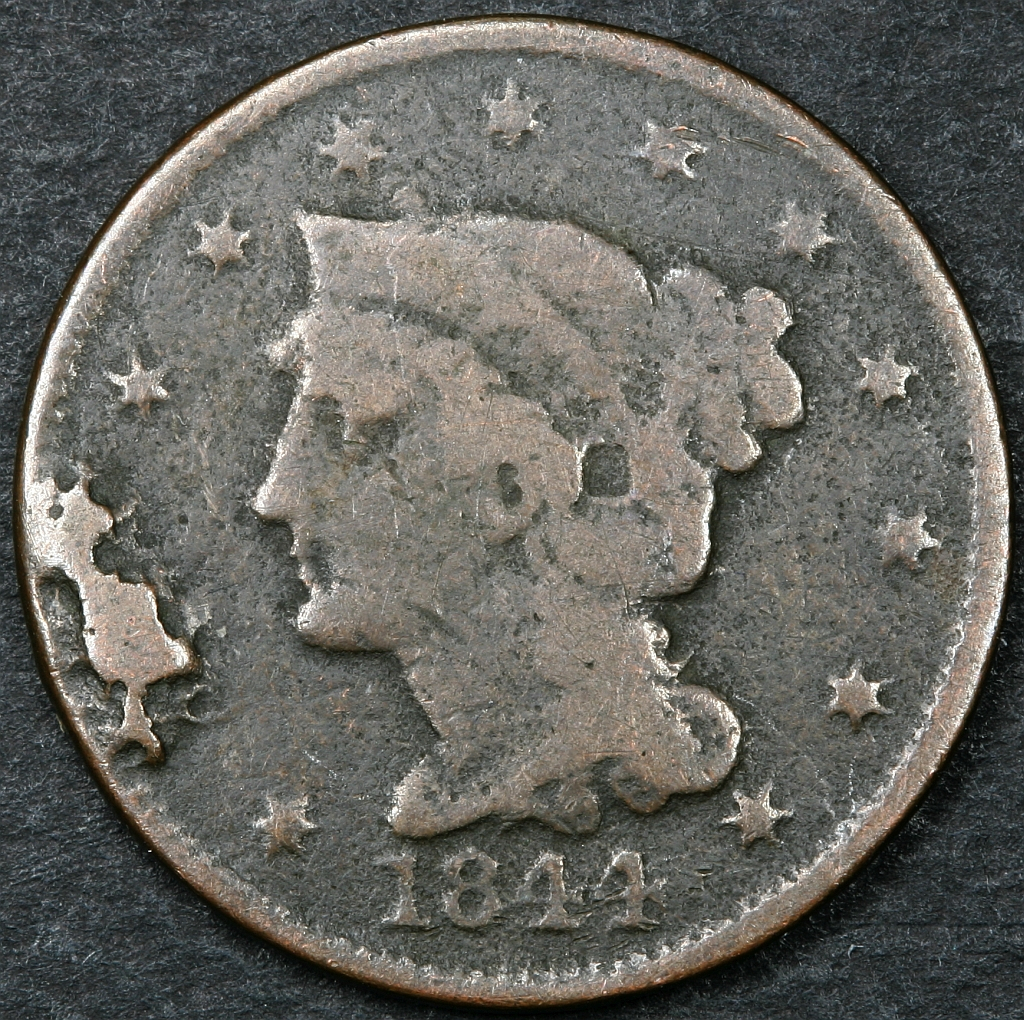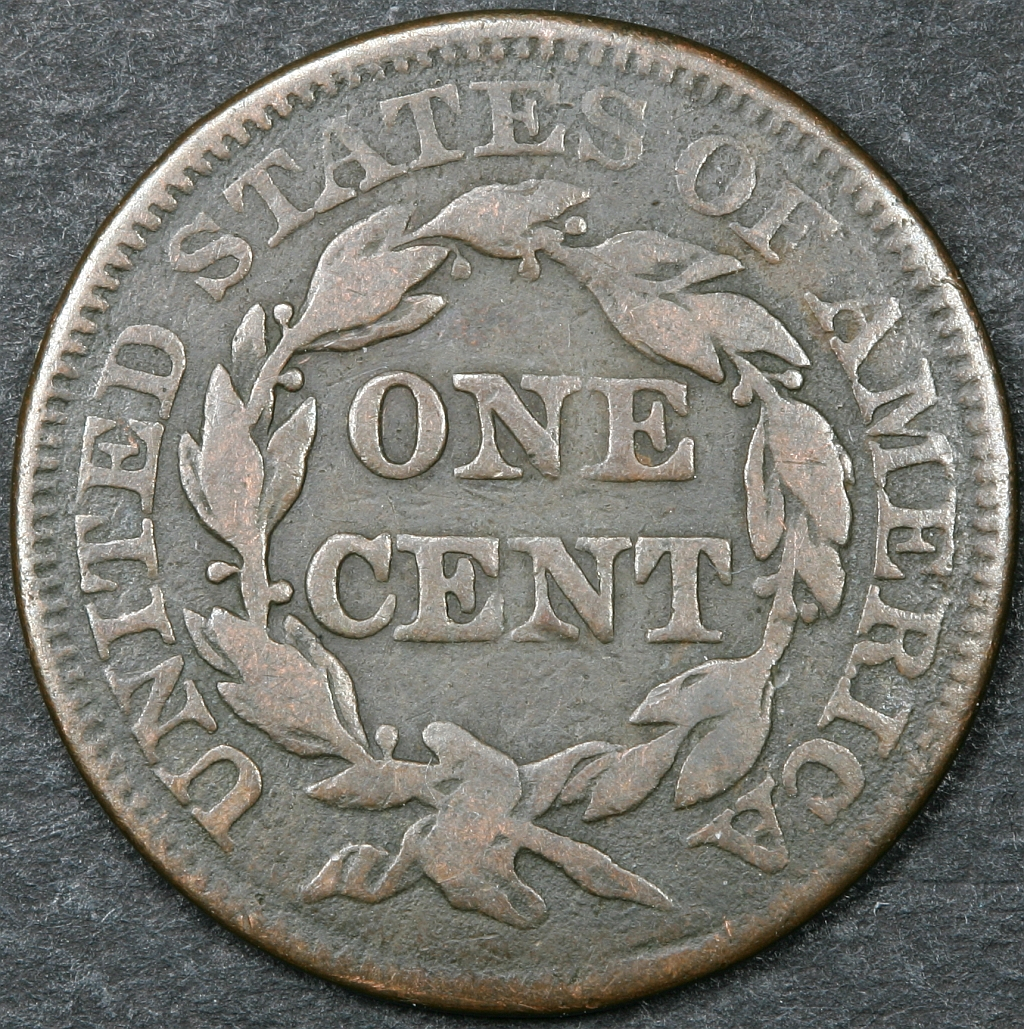1844 Large Cent Mystery
 cmerlo1
Posts: 7,963 ✭✭✭✭✭
cmerlo1
Posts: 7,963 ✭✭✭✭✭
I found this in a dealer's box of 2X2's at the Bellaire Coin Club show in Houston yesterday. What caught my eye was was that it looked visibly smaller than the other large cents in the box. It was cheap, so I bought it thinking (and hoping) it's a contemporary counterfeit and a needed one for my contemporary counterfeit type collection. Upon examination after I got it home, I found:
- Its diameter is 25.5 mm, 2 mm smaller than the normal size.
- It lacks the thick rim that other 1844 cents have.
- It is underweight by almost 3 grams.
- It is visibly thinner than a normal 1844 large cent.
- The obverse is porous and has a cud-like blob of metal on it.
- The reverse is sharp and clear. It does not have corresponding weak area to the 'cud' on the other side.
- It appears to be perfectly round and centered.
My first thought was that the coin sat in an acidic solution, but if it did, how did the reverse remain untouched, and how did the thick rim get dissolved on both sides? Also, why would a counterfeit be so obviously smaller and thinner than an authentic coin. It obviously circulated, so if it is bad it was passed successfully many times. Unless I'm overlooking something obvious, this coin is a mystery to me...
Any thoughts on this?


Comments
That is a head-scratcher. I think "cud-like" is the right way to put it - I don't think there is a known variety with a cud in that postion.
Smitten with DBLCs.
Could be acid on just the obverse - make a shallow pool and put the obverse down into it.
Cast counterfeit?
It passes the ring test...
If it was cast of copper or bronze I assume it would also ring?
I know the ring test isn't 100% effective, but I have tried it in the past on cast coins and the result was a ring, but a much shorter one.
Edited to add- While the outside design on the reverse appears porous, the inner lettering appears struck up to me...
I would say acid or corrosion reduced the dimensions, but the "cud" is a problem as I have never seen a die break like that. It is reminiscent of the irregularities often found in sand casting.
Odd. If someone was trying to strike their own using smaller planchets... and coming out 3 grams of copper ahead per cent. Doesn't seem worth it. Interesting piece!
Successful BST transactions with: SilverEagles92; Ahrensdad; Smitty; GregHansen; Lablade; Mercury10c; copperflopper; whatsup; KISHU1; scrapman1077, crispy, canadanz, smallchange, robkool, Mission16, ranshdow, ibzman350, Fallguy, Collectorcoins, SurfinxHI, jwitten, Walkerguy21D, dsessom.
What does it look like from the edge, where the "cud" is? It looks very raised in the image, like close to original thickness?
I wonder if it could have been buried up against another coin, such that the corrosion only seeped in from the edges on the reverse. Just a thought.
I’m going with genuine, acid etched, face up in the container, giving the reverse some protection/minimal exposure to the solution.
I have no theory on that blob on the obverse, other than it occurred post mint, and has been on the coin for a very long time.
I recall some years ago there was a company that made replica large cents that were not proper size, but I think it was a date that did not actually exist for the series.
Here are a couple of photos of the edge. The first one is the edge where the 'cud' is. Hard to see in the photo, but there is a small flat spot there (perhaps where the channel in the mold was and the resulting burr was removed?) The other is from another random spot. One thing to note- the edge appears smooth and is not porous like the obverse of the coin.
With something stuck on it that protected that one area.
Obverse is too much a mess to tell but the reverse looks wrong to me. I vote counterfeit.
Successful BST deals with mustangt and jesbroken. Now EVERYTHING is for sale.
I would vote for cast counterfeit.... Though the size is confusing....thin and diameter off...Perhaps a home made mold rather than from a pressed original. Cheers, RickO
I recall reading that metal castings will shrink a little when cooled. That could explain the smaller dia , metal blob, and flat edge (from the sprue). Although it could still be corroded or acid etched, I'm leaning towards cast fake. Maybe contemporary? (just throwing that out there)
Yes.
I know of a jewelry maker who makes cast sterling silver miniatures of sea shells, etc. She gets to the small size by starting with the genuine object, then making a casting, then making a casting of the casting etc., etc. until the size is reduced to what she was looking for.
Me thinks it is a dug find that was obv up and exposed to mineralization and chemicals for a long time. I dig coins a lot where the down side is clean and sharp due to soil compression that appears to protect that side from the damages of time. Peace Roy
BST: endeavor1967, synchr, kliao, Outhaul, Donttellthewife, U1Chicago, ajaan, mCarney1173, SurfinHi, MWallace, Sandman70gt, mustanggt, Pittstate03, Lazybones, Walkerguy21D, coinandcurrency242 , thebigeng, Collectorcoins, JimTyler, USMarine6, Elkevvo, Coll3ctor, Yorkshireman, CUKevin, ranshdow, CoinHunter4, bennybravo, Centsearcher, braddick, Windycity, ZoidMeister, mirabela, JJM, RichURich, Bullsitter, jmski52, LukeMarshall, coinsarefun, MichaelDixon, NickPatton, ProfLiz, Twobitcollector,Jesbroken oih82w8, DCW